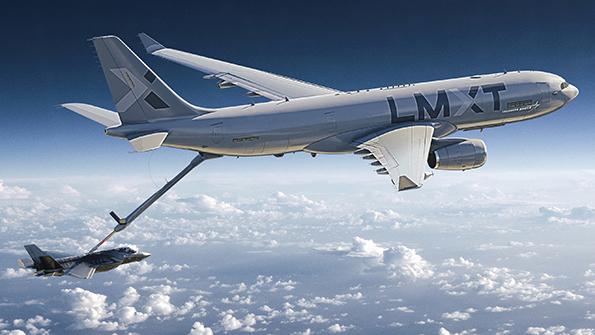Lawmakers Plan To Pressure USAF To Continue Bridge Tanker Competition

Lockheed Martin is prepared to work with Airbus on a modified A330 Multi-Role Tanker Transport for the bridge tanker program.
The U.S. Air Force is likely to skip a competition for its KC-Y “bridge tanker” and instead focus on the next-generation, clean-sheet KC-Z. However, some lawmakers want to force the service to move ahead with that competition in the next budget cycle because an alternative plan to buy more Boeing KC-46As without competing would not be acceptable.
Some members of the House Armed Services Committee (HASC) this year attempted to put more pressure on the service to move ahead with the KC-Y, but the proposed amendment was defeated in the early morning hours of the marathon June markup. A congressional staffer tells Aviation Week that if Republicans gain control of the House next year and take over the HASC, members are likely to try again to create a requirement for the competition.
- KC-Y competition would be between Boeing’s KC-46 and Lockheed Martin’s LMXT
- Decision hinges on next-generation KC-Z acquisition timeline
“I think what we’re going to have to do is push them,” Rep. Rob Wittman, (R-Va.), ranking member of the HASC’s seapower and projection forces subcommittee, tells Aviation Week. “Obviously, we’re not going to be able to do anything within this year’s [National Defense Authorization Act] as the Senate takes it up. So it’s not going to be anything that we can get accomplished now.
“But I think what we have to do as members—not only seapower and projection forces but also the entire committee needs to say: ‘Well, if you’re not going to do [the KC-Y], then what is your vision?’” Wittman adds. “What is your vision for making sure you have an aircraft that has the future capabilities in an environment that is going to be even more dynamic than where we are?’ I mean, to me, it is somewhat shortsighted.”
The Air Force announced the KC-Y competition in June 2021, with Boeing offering its KC-46 and Lockheed Martin offering the LMXT, a modified Airbus A330 Multi-Role Tanker Transport. However, Air Force Secretary Frank Kendall said in rolling out the service’s budget this year that a competition is looking less likely, as requirements tend to favor more KC-46s.
Wittman says he is not pleased, though, with how long it has taken the KC-46 to progress and obtain a new remote-vision system. “So I’m not happy that they have punted on [the KC-Y],” he says.
The service is still working on the requirements ahead of a final request for proposal expected in fiscal 2023, following validation by the Joint Requirements Oversight Council, the Air Force says in a statement. The acquisition strategy for tanker recapitalization is still being defined, and if the KC-Y moves ahead, the service says the goal is “uninterrupted recapitalization for the aging tanker fleet after the final KC-46A delivery scheduled for 2029.” In August, Air Force acquisition boss Andrew Hunter said the decision on the competition would coincide with the next proposed budget release in the spring.
For some lawmakers, the key will be how the Air Force moves ahead with the future KC-Z. The congressional staff member who spoke to Aviation Week says the Air Force has briefed Capitol Hill that it expects to field the KC-Z in the 2040 time frame, which would leave about 11 years from the last KC-46 delivery to the first KC-Z. The Air Force would need a large sole-source buy of KC-46s to meet its requirements for enough tankers if there is not a competition. Given that members of Congress are already frustrated by the long process of making the KC-46 operational, with the latest schedule targeting October 2025, a large buy for more of that aircraft is not a popular idea among some on Capitol Hill.
The Air Force wants to accelerate the KC-Z and has said it will begin the pre-analysis of alternatives work next year. Previously, this was not expected until 2030. However, with the KC-Z to be a full, clean-sheet design that could incorporate more advanced technologies and different designs, including possibly a blended wing body, moving it forward in any meaningful way seems unlikely.
If the Air Force can move the KC-Z program forward to the point where it would require only one or two years of additional acquisitions of more KC-46s, the lawmakers could go along with that, the staffer says. But that would need to be outlined relatively quickly, with the next budget cycle another “target of opportunity” to have the Air Force proceed with a KC-Y competition.
In June, the service released a solicitation for an Advanced Aerial-Refueling Family of Systems for the KC-Z, looking at capabilities including stealth, improved situational awareness, self-protection and autonomy, among others.
Lt. Gen. Clint Hinote, the head of Air Force Futures, tells Aviation Week that the service needs to use advanced modeling and simulation to inform what kind of tanker it wants in the future. For example, if the service wants to proceed with future operational concepts, including increased use of heavy bombers and palletized munitions from large aircraft, that in turn would require large tankers with greater amounts of fuel to be offloaded at range. However, if the service instead is looking at using a larger number of smaller aircraft, including possibly refuelable uncrewed aircraft systems, that would require smaller tankers in larger numbers.
“We don’t know how far we want to accelerate,” Hinote says. “I think the learning that we have to do to get what would feel like an [analysis of alternatives] that we can be confident in, that’s a lot of learning that has to happen in a fairly short amount of time. There are ways that we may be able to accelerate that learning.”





